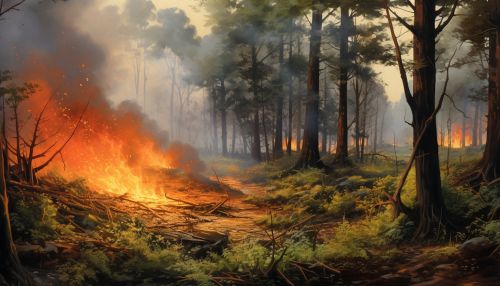Rothermel Fire Spread Model
Introduction
The Rothermel Fire Spread Model is a mathematical model developed by Richard C. Rothermel in 1972, which is used to predict the rate of spread of forest fires. The model takes into account various factors such as fuel type, fuel moisture, wind speed, and slope of the terrain. It has been widely adopted in fire management and research, and forms the basis for many fire behavior prediction systems used today Fire Behavior Prediction Systems.


Development of the Model
Rothermel developed the model while working at the Intermountain Fire Sciences Laboratory in Missoula, Montana. The model was based on a series of controlled burn experiments and extensive data collection. Rothermel's work was a significant contribution to the field of wildland fire science, and his model remains a cornerstone of fire behavior prediction.
Mathematical Formulation
The Rothermel model is based on the conservation of energy principle. It assumes that the rate of spread of a fire is directly proportional to the heat transfer efficiency and the fuel consumption rate. The model is expressed as a set of differential equations, which can be solved numerically to predict the rate of spread of a fire under given conditions.
The model takes into account the following factors:
- Fuel type: Different types of vegetation burn at different rates. The model includes a set of fuel models, each representing a different type of vegetation.
- Fuel moisture: The moisture content of the fuel affects its flammability. The model includes a moisture of extinction parameter, which represents the moisture content at which a fuel will not burn.
- Wind speed: Wind can significantly increase the rate of spread of a fire. The model includes a wind function, which represents the effect of wind speed on the rate of spread.
- Slope: The slope of the terrain can also affect the rate of spread of a fire. The model includes a slope function, which represents the effect of slope on the rate of spread.
Applications
The Rothermel model is used in a variety of applications, including fire behavior prediction, fire management planning, and fire research. It forms the basis for several fire behavior prediction systems, including the National Fire Danger Rating System (NFDRS) and the Fire Behavior Assessment Tool (FBAT). The model is also used in fire simulation software, such as FARSITE and FlamMap.
Limitations and Criticisms
While the Rothermel model is widely used, it has several limitations. The model assumes steady-state conditions, which means it does not account for changes in weather or fuel conditions over time. It also assumes homogeneous fuel conditions, which is often not the case in real-world scenarios.
The model has also been criticized for its complexity. The model involves a large number of parameters, many of which are difficult to measure in the field. This has led to the development of simplified versions of the model, as well as alternative models that are easier to use.
Future Developments
Despite its limitations, the Rothermel model continues to be a valuable tool in fire behavior prediction. Recent advances in technology, such as remote sensing and geographic information systems (GIS), have made it possible to collect more accurate and detailed data on fuel and weather conditions. This data can be used to improve the accuracy of the model and extend its applicability to a wider range of conditions.
